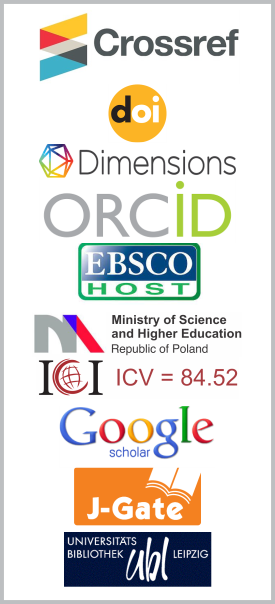Head Shape Variation in Cnaphalocrocismedinalis (Guenee) Larvae Associated with Different Rice Varieties
DOI:
https://doi.org/10.26713/jims.v9i4.1011Keywords:
Rice leaf, CnaphalocrosismedinalisAbstract
Cnaphalocrosismedinalis is considered a dominant insect pest of rice throughout the rice growing areas in the Philippines. Its head, a morphological trait, is specialized for food gathering and manipulation, including its relation to bite performance and ecology has been used for investigating the integration of different phenotypic components. Because of the role of this structure in the insect pest, we quantitatively describe the amount of morphometric variation between populations of the pest collected from different rice hosts. Landmark-based geometric morphometrics method was used to quantify and analyze head shape variation by the application of statistical methods of the relative warp scores. Based on the results of the assessment, significant variations in head shapes between populations of the insect were observed and argued to be due to the selection exerted by the host.Downloads
References
K. Ramasubbaiah, P.S. Rao and A.G. Rao, Nature of damager and control of rice leaf folder, Indian J. Enomol. 42, 214 – 7 (1980).
H.M. Singh, R.K. Srivastava, S.M.A. Rizvi, F.A. Elazegui, N.P. Castilla and S. Savary, Yield reduction due to brown spot and leaf folder injuries and various levels of fertilizers and water supply to rice crop, Annals of Plant Prot. Sci. 11, 16 – 19 (2003).
D.L. Calle, M.L. Quinones, H.F. Erazo and O.N. Jaramillo, Morphometric discrimination of females of five species of Anopheles of the subgenus Nyssorhynchus from Southern and Northwest Colombia, Mem. Inst. Oswaldo Cruz. 97, 1191 – 1195 (2002).
J. Villegas, M.D. Feliciangeli and J.P. Dujardin, Wing shape divergence between Rhodniusprolixus from Cojedes (Venezuela) and Rhodniusrobustus form Merida (Venezuela), Inf. Gen. Evol. 2, 121–8 (2002).
F.L. Bookstein, Biometrics, biomathematics and the morphometric synthesis, Bulletin of Mathematical Biology 58(2), 313 – 365 (1996).
J. Kingsolver and R.B. Huey, Introduction: the evolution of morphology, performance, and fitness, Integrative and Comparative Biology 43, 361 – 366 (2003).
P.C. Wainwright, Functional versus morphological diversity in macro evolution, Annual Review of Ecology, Evolution & Systematics 38, 381 – 401 (2007).
F.J. Rohlf, tpsUTIL, Version 1.28, Dept Ecol. & Evol., St. Univ. New York, Stony Brook, New York (2004).
D.C. Adams, F.J. Rolhf and D.E. Slice, Geometric Morphometrics: Ten years of progress following revolution, Ital. J. Zool. 71, 5 – 16 (2004).
I.L. Dryden and K.V. Mardia, Statistical shape analysis, Statistics in Medicine 19(19), 2716 – 2717 (1998).
O. Hammer, D.A.T. Harper and P.D. Ryan, PAST: Paleontological Statistics Software Package for Education and Data Analysis, Paleontol Electron 4(1), 1 – 9 (2001).
B.J. Alicea, Evaluating Intraspecific Variations and Intersepcific Diversity, Comparing Humans and Fish Species (2002).
M.A.J. Torres, J. Lumansoc and C.G. Demayo, Variability in head shapes in three populations of the Rice Bug Leptocorisaoratorius(Fabricius) (Hemiptera: Alydidae), Egypt. Acad. J. Biol. Sci. 3, 173 – 184 (2010).
N. Khiaban, K. Haddad Irani-Nejad, M.S. Hejazi, S.A. Mohammadi and N. Sokhandan, A geometric morphometric study on geographical Iranian populations of the pod borer, Helicoverpaarmigera (Lepidoptera: Noctuidae), Journal of Entomological Society of Iran 29(2(45)), 13 – 14 (2010).
Downloads
Published
How to Cite
Issue
Section
License
Authors who publish with this journal agree to the following terms:- Authors retain copyright and grant the journal right of first publication with the work simultaneously licensed under a CCAL that allows others to share the work with an acknowledgement of the work's authorship and initial publication in this journal.
- Authors are able to enter into separate, additional contractual arrangements for the non-exclusive distribution of the journal's published version of the work (e.g., post it to an institutional repository or publish it in a book), with an acknowledgement of its initial publication in this journal.
- Authors are permitted and encouraged to post their work online (e.g., in institutional repositories or on their website) prior to and during the submission process, as it can lead to productive exchanges, as well as earlier and greater citation of published work.




